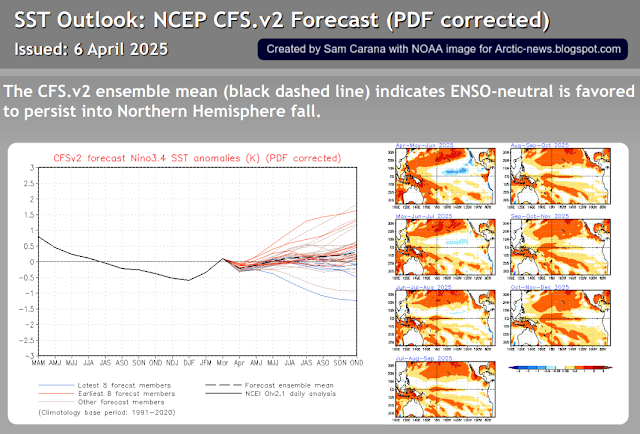 |
| [ click on images to enlarge ] |
On September 13, 2025, the temperature reached an anomaly in this area of -0.54°C versus 1991-2020, indicating that La Niña conditions are likely to dominate late 2025/early 2026. The inset on the above image shows the Niño 3.4 area and sea surface temperature anomalies versus 1991-2020 on that day.
The image on the right, adapted from NOAA, shows the ENSO outlook (CFSv2 ensemble mean, black dashed line) favoring La Niña late 2025/early 2026.
 |
| [ image from earlier post ] |
Rising temperature in absence of El Niño
Critical is the temperature on land, which is after all where people live. The image below shows that in 2025, monthly temperature anomalies (from 1880-1920) on land have fallen from a high of +2.93°C in January 2025 to +1.45°C in July 2025, in line with the temperature suppression that comes with a move into La Niña.
The anomaly was +2.93°C in January 2025, very close to +3°C. Note that when using a genuinely pre-industrial base, anomalies can be much higher than depicted in the above image. While anomalies have come down somewhat, the anomaly rose again to +1.82°C in August 2025, which could indicate that acceleration of the temperature rise is overwhelming the temperature suppression that comes with a move into La Niña.
The sea surface temperature anomaly keeps rising, in particular from the latitudes of 30° and higher north, as illustrated by the image below.
Adding to fears that the temperature rise is accelerating despite the absence of El Niño is the most recent rise of the global temperature anomaly. As illustrated by the image below, the global temperature anomaly versus 1991-2020 has risen strongly recently, from +0.21°C on July 4, 2025, to +0.83°C on September 20, 2025.
A +3°C temperature rise constitutes an important threshold, since humans will likely go extinct with such a rise, as illustrated by the image below.
 |
| [ from the post When will humans go extinct? ] |
 |
| [ from: When Will We Die? ] |
Note that healthy vegetation relies not only on temperature, but also on the presence of good soil, microbes, rain, soil nutrients, pollinators, habitat, groundwater and an absence of toxic waste, pests and diseases.
A 2018 study by Strona & Bradshaw indicates that most life on Earth will disappear with a 5°C rise (see box on the right). Humans, who depend on a lot of other species, will likely go extinct with a 3°C rise, as discussed in the earlier post When Will We Die?
The map below shows the size of the population rather than the size of the territory, decreasing the size of Canada, Mongolia, Australia, and Russia, and highlighting how many people are vulnerable to heat stress.
 |
| [ cartogram from Ourworldindata.org - click to enlarge ] |
Climate Emergency Declaration
The temperature rise is accelerating and the rise could accelerate even more due to decreases in buffers (as described in earlier posts such as this one), due to strengthening feedbacks, especially during an El Niño, and due to further reduction of the aerosol masking effect, which are all developments that could rapidly speed up existing feedbacks and trigger new feedbacks.
The situation is dire and the precautionary principle calls for rapid, comprehensive and effective action to reduce the damage and to improve the situation, as described in this 2022 post, where needed in combination with a Climate Emergency Declaration, as discussed at this group.
The situation is dire and the precautionary principle calls for rapid, comprehensive and effective action to reduce the damage and to improve the situation, as described in this 2022 post, where needed in combination with a Climate Emergency Declaration, as discussed at this group.
• NOAA - Climate Prediction Center - ENSO: Recent Evolution, Current Status and Predictions
https://www.cpc.ncep.noaa.gov/products/analysis_monitoring/lanina/enso_evolution-status-fcsts-web.pdf
https://charts.ecmwf.int/products/seasonal_system5_nino_annual_plumes
• NASA - surface temperature analysis - gistemp
https://data.giss.nasa.gov/gistemp
• When Will We Die?
https://arctic-news.blogspot.com/2019/06/when-will-we-die.html
• Population cartogram
https://ourworldindata.org/world-population-cartogram
discussed on Facebook at:
https://www.facebook.com/groups/arcticnews/permalink/10163232140864679
• Transforming Society
https://arctic-news.blogspot.com/2022/10/transforming-society.html
• Climate Plan
https://arctic-news.blogspot.com/p/climateplan.html
• Climate Emergency Declaration
https://arctic-news.blogspot.com/p/climate-emergency-declaration.html
https://www.facebook.com/groups/arcticnews/permalink/10163232140864679
• Transforming Society
https://arctic-news.blogspot.com/2022/10/transforming-society.html
• Climate Plan
https://arctic-news.blogspot.com/p/climateplan.html
• Climate Emergency Declaration
https://arctic-news.blogspot.com/p/climate-emergency-declaration.html























































